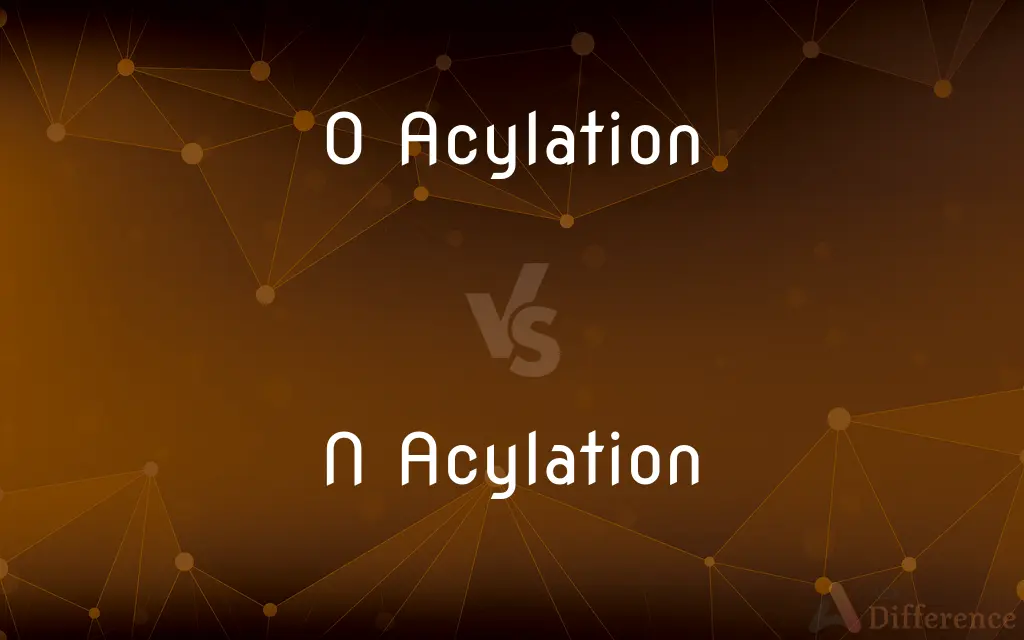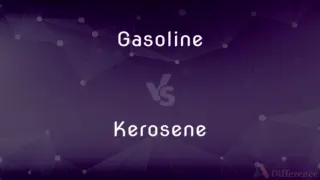O Acylation vs. N Acylation — What's the Difference?
By Tayyaba Rehman — Published on January 31, 2024
O-Acylation involves attaching an acyl group to an oxygen atom, commonly seen in ester formation. N-Acylation involves attaching an acyl group to a nitrogen atom, often forming amides.

Difference Between O Acylation and N Acylation
Table of Contents
ADVERTISEMENT
Key Differences
O-Acylation is a chemical process where an acyl group (typically derived from an acid) is bonded to an oxygen atom in a molecule. This reaction is fundamental in organic chemistry and is a key step in the synthesis of esters, a major class of organic compounds. In contrast, N-Acylation involves the bonding of an acyl group to a nitrogen atom, which is a central process in the formation of amides. Amides are another significant class of organic compounds, essential in both synthetic and biological chemistry.
The O-Acylation reaction is commonly seen in the production of esters from carboxylic acids and alcohols. This reaction often requires a catalyst or activating agent and is used in various applications, including the manufacture of plastics, fragrances, and pharmaceuticals. N-Acylation, on the other hand, typically involves the reaction of carboxylic acids or their derivatives with amines or ammonia, resulting in the formation of amides. This reaction is crucial in peptide bond formation, protein synthesis, and the production of many synthetic materials.
In O-Acylation, the acyl group is transferred to an oxygen atom, which typically belongs to a hydroxyl (-OH) group. This process can be reversible under certain conditions. In N-Acylation, the acyl group is attached to a nitrogen atom, usually part of an amine group. N-Acylation reactions are key in modifying the properties of molecules, especially in drug design, where they can alter solubility, stability, and biological activity.
The mechanisms of these reactions differ significantly. O-Acylation can occur under acidic or basic conditions and often involves a nucleophilic attack by the oxygen atom on the acyl group. N-Acylation generally requires activating the acyl compound to make it more reactive towards the nitrogen nucleophile. This activation can be achieved through various methods, including the use of coupling reagents in peptide synthesis.
In practical applications, O-Acylation is crucial for producing various esters used in solvents, plasticizers, and synthetic flavors. N-Acylation has a profound impact in biochemistry and medicine, particularly in the synthesis of pharmaceuticals, where specific amide linkages are crucial for the activity of many drugs.
ADVERTISEMENT
Comparison Chart
Bond Formation
Acyl group to oxygen atom
Acyl group to nitrogen atom
Common Products
Esters
Amides
Typical Reactants
Carboxylic acids and alcohols
Carboxylic acids and amines
Mechanism
Often involves nucleophilic attack on oxygen
Involves activation of acyl compound
Applications
Plastics, fragrances, pharmaceuticals
Protein synthesis, drug design
Compare with Definitions
O Acylation
Bonding of an acyl group to an oxygen atom.
O-Acylation was used to synthesize the ester needed for the fragrance.
N Acylation
Alters solubility and stability in drug design.
The drug's properties were modified through targeted N-Acylation.
O Acylation
Essential in manufacturing plastics and pharmaceuticals.
The plasticizer was obtained through the O-Acylation process.
N Acylation
A reaction forming amides from acids and amines.
Through N-Acylation, the chemist produced the necessary amide linkage.
O Acylation
Often catalyzed by acid or base.
Acid catalysis facilitated the O-Acylation in the lab experiment.
N Acylation
Requires activation of the acyl compound.
Effective N-Acylation was achieved by activating the acyl precursor.
O Acylation
Involves a nucleophilic attack by oxygen.
The oxygen's nucleophilic attack during O-Acylation formed the desired ester.
N Acylation
Attachment of an acyl group to a nitrogen atom.
N-Acylation was crucial in synthesizing the amide bond in the drug.
O Acylation
A reaction to form esters from acids and alcohols.
O-Acylation is a key step in producing various synthetic flavors.
N Acylation
Central in peptide bond formation and protein synthesis.
N-Acylation plays a vital role in constructing proteins in cells.
Common Curiosities
What are common products of N Acylation?
N Acylation typically results in the formation of amides.
How is O Acylation used in industry?
It's used in making plastics, fragrances, and pharmaceuticals.
What is O Acylation?
It's the chemical bonding of an acyl group to an oxygen atom.
What are typical products of O Acylation?
O Acylation commonly produces esters.
What reactants are used in N Acylation?
Typically carboxylic acids and amines or ammonia.
What role does N Acylation play in biochemistry?
It's crucial for peptide bond formation and protein synthesis.
What does N Acylation involve?
It involves bonding an acyl group to a nitrogen atom.
What catalyzes O Acylation?
O Acylation can be catalyzed by acids or bases.
What is a nucleophilic attack in O Acylation?
It's when an oxygen atom attacks the acyl group to form an ester.
What are the reactants in O Acylation?
Usually carboxylic acids and alcohols.
Can O Acylation be reversible?
Yes, under certain conditions, O Acylation can be reversible.
Is N Acylation reversible?
It's generally not reversible and forms stable amide bonds.
How is the acyl compound activated in N Acylation?
Through various methods, including using coupling reagents.
Are O Acylation and N Acylation reactions common in organic chemistry?
Yes, they are fundamental reactions in organic synthesis and biochemistry.
Why is N Acylation important in drug design?
It can alter the solubility, stability, and activity of pharmaceuticals.
Share Your Discovery

Previous Comparison
Gasoline vs. Kerosene
Next Comparison
Feta Cheese vs. Ricotta CheeseAuthor Spotlight
Written by
Tayyaba RehmanTayyaba Rehman is a distinguished writer, currently serving as a primary contributor to askdifference.com. As a researcher in semantics and etymology, Tayyaba's passion for the complexity of languages and their distinctions has found a perfect home on the platform. Tayyaba delves into the intricacies of language, distinguishing between commonly confused words and phrases, thereby providing clarity for readers worldwide.













































